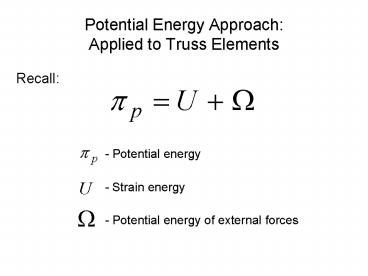Potential Energy Approach: Applied to Truss Elements PowerPoint PPT Presentation
Title: Potential Energy Approach: Applied to Truss Elements
1
Potential Energy ApproachApplied to Truss
Elements
- Recall
2
Potential Energy of a Spring
3
Potential Energy of a Truss Element
4
Truss Element Strain Energy
5
Strain Energy Axial Loading
6
Truss Element Loading
7
Potential Energy of a Truss Element
8
Using Finite Element NotationStrain Energy Term
9
Using Finite Element NotationApplied Load Terms
- Concentrated Forces
- Surface Traction
10
Applied Load Terms (cont.)
Body Forces Work equivalent concentrated
forces
11
Potential Energy Matrix Form
12
Linearly Varying Load
13
Mesh Refinement
14
Mesh Refinement (cont.)
15
Mesh Refinement (cont.)
16
Mesh Refinement (cont.)
17
Mesh Refinement (cont.)
18
Chapter 4. Development of Beam Equations
- Recall
- Truss (or bar) elements are subjected to axial
tensile or compressive forces only (no bending)
and deform by change in length - Beam elements (Chapter 4) - deform by bending
- Frame elements (Chapter 5) combined axial,
bending, and torsional deformation
19
Typical problem
20
Review Beam Theory
M moment distribution E Youngs modulus
I Moment of Inertia of cross-section v
transverse displacement V shear load w
distributed load
21
Beam Theory (cont.)
- If EI constant and only concentrated loads and
moments are applied, i.e. w(x)0 - Solution (exact)
22
Beam Element - Definitions
23
Sign Conventions FEA formulatoin vs. Beam theory
24
Steps in the Finite Element Method
- Discretize the region and select element type
- Select a displacement function
- Define the strain/displacement and stress/strain
relations - Derive the element equations
- Direct Stiffness Method
- Energy Methods
- Method of Weighted Residuals (Galerkins method)
- Assemble global equations and impose boundary
conditions - Solve for unknown nodal displacements
- Solve for element strains and stresses
- Interpret results
PowerShow.com is a leading presentation sharing website. It has millions of presentations already uploaded and available with 1,000s more being uploaded by its users every day. Whatever your area of interest, here you’ll be able to find and view presentations you’ll love and possibly download. And, best of all, it is completely free and easy to use.
You might even have a presentation you’d like to share with others. If so, just upload it to PowerShow.com. We’ll convert it to an HTML5 slideshow that includes all the media types you’ve already added: audio, video, music, pictures, animations and transition effects. Then you can share it with your target audience as well as PowerShow.com’s millions of monthly visitors. And, again, it’s all free.
About the Developers
PowerShow.com is brought to you by CrystalGraphics, the award-winning developer and market-leading publisher of rich-media enhancement products for presentations. Our product offerings include millions of PowerPoint templates, diagrams, animated 3D characters and more.

